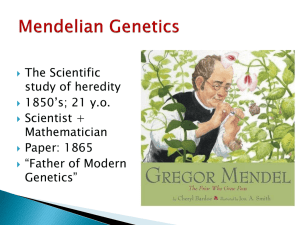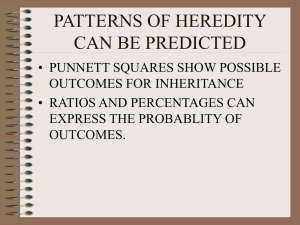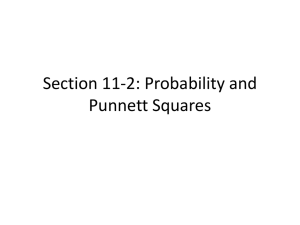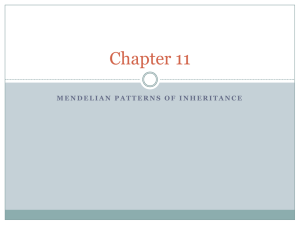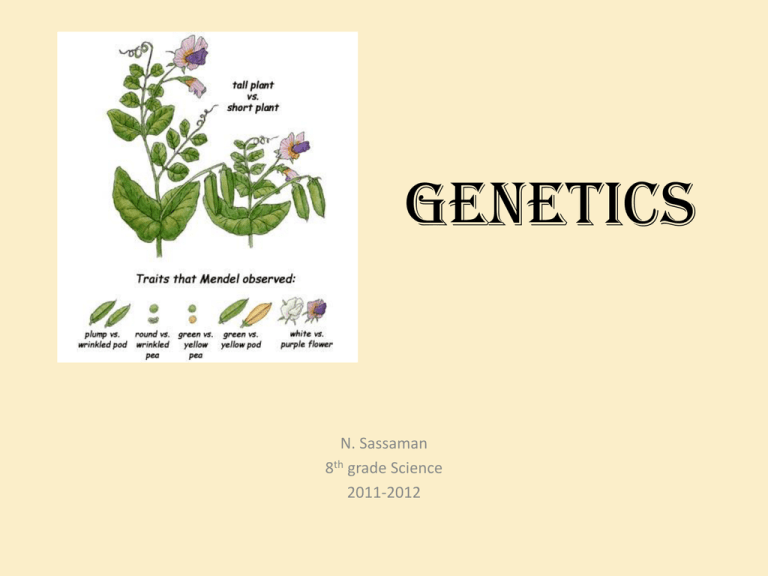
Genetics
N. Sassaman
8th grade Science
2011-2012
Chromosomes, Genes, and Alleles
Chromosomes are made up of
many genes joined together like
beads on a string. The
chromosomes in a pair may have
different alleles for some genes
and the same allele for others.
DNA – the genetic material that carries
information about an organism and is
passed from parent to offspring.
Dominant vs. Recessive Alleles
Gregor Mendel’s experiments
In all of Mendel’s crosses, only
one form of the trait (dominant)
appeared in the F1 generation.
However, in the F2 generation,
the “lost” form (recessive) of the
trait always reappeared in
about one fourth of the plants.
Trait – a characteristic
that an organism can
pass on to its offspring
through its genes.
#1-5 on p. 12 packet
Dominant vs. Recessive Alleles
Letters are used to represent the
alleles for a certain trait.
A capital letter is used for dominant
trait (allele).
A lowercase letter is used for recessive
trait (allele).
Examples: (see chart above)
T = Tall height
G = green pod
t = short height g = yellow pod
R = round seed Y = yellow seed
r = wrinkled seed y = green seed
#6-13 on p. 12 packet
Homozygous vs. Heterozygous
REMEMBER: each gene for a trait has TWO possible
variations called alleles. (one from mother, one from father)
THEREFORE: we assign TWO letters to an individual
to represent which two alleles they have.
Examples: (see chart above)
T = Tall height
t = short height
Height
TT = tall plant
Tt = tall plant
tt = short plant
G = green pod
g = yellow pod
Pod color
GG = green
Gg = green
gg = yellow
R = round seed
r = wrinkled seed
Seed shape
RR = round
Rr = round
rr = wrinkled
Y = yellow seed
y = green seed
Seed color
YY = yellow
Yy = yellow
yy = green
Homozygous vs. Heterozygous
Homozygous (purebred) – having TWO OF
THE SAME alleles for a trait. (homo = same)
Heterozygous (hybrid) – having TWO
DIFFERENT alleles for a trait. (hetero = different)
Height
TT = tall plant
Tt = tall plant
tt = short plant
Pod color
GG = green
Gg = green
gg = yellow
TT = homozygous tall (dominant)
tt = homozygous short (recessive)
Tt = heterozygous tall
GG = homozygous green pod (dominant)
gg = homozygous yellow pod (recessive)
Gg = heterozygous green pod
Phenotype vs. Genotype
An organism’s phenotype is
its physical appearance, or
visible traits, and an
organism’s genotype is its
genetic makeup, or allele
combinations.
pheno = physical
(appearance)
geno = genes
(allele combo)
Ex/ tall or short
Ex/ TT, Tt, or tt
#1-3 on p. 16 packet; #1-3 on p. 18 packet
Codominance and Incomplete
Dominance
Not all alleles for traits are expressed as a dominant/recessive relationship.
Codominance occurs when there are two
variation of a trait (two alleles), but
neither one is dominant over the other.
As a result, BOTH alleles are
expressed if present in an individual.
FB = black feathers
FW = white feathers
FBFB = black feathers
FWFW = white feathers
FBFW = BOTH black and white feathers
Codominance and Incomplete
Dominance
Not all alleles for traits are expressed as a dominant/recessive relationship.
Incomplete dominance occurs when one allele for
a trait is not completely dominant over the other
allele.
As a result, there is a ‘blending’ of the two
specific traits.
R = red flowers
R’R’
RR’
R’ = white flowers
RR = red flowers
R’R’ = white flowers
RR’ = pink flowers
NOTE: the letters used to represent this type of
inheritance pattern vary. Sometimes
capital/lowercase are used, sometimes
capital/capital prime, sometimes two capital
letters. Always read problems carefully.
Probability and Punnett Squares
In a genetic cross, the allele that each
parent will pass on to its offspring is
based on probability, the likelihood
that a particular event will occur.
For example:
Mendel was the first scientist to
recognize that the principles of
probability can be used to predict
the results of genetic crosses.
coat color in guinea pigs
Homozygous black (BB) X homozygous white (bb)
Geneticists use Punnett squares to show all the
possible outcomes of a genetic cross and to
determine the probability of a particular
outcome.
Probability and Punnett Squares
How to set up a Punnett Square:
1. Draw a box with four (4) quadrants.
2. Take one parent and write its alleles ABOVE the
two columns.
3. Take the other parent and write its alleles NEXT
TO the two rows.
4. Fill in each of the boxes by writing the letters
(alleles) that ‘match up’ in that box.
How to calculate probability:
1. From a Punnett square, all results will be expressed as ‘…out of 4’ or ‘-/4’.
For example: 2 out of 4 OR 2/4 of the offspring above have the genotype Tt.
1 out of 4 OR 1/4 of the offspring above have the genotype tt or TT.
2. A percent can then be calculated by dividing the fraction through and X 100 to get
2/ X 100 = 50%
percent (%).
¼ X 100 = 25%
4
# 4-5 on p. 16 packet; #5 on p. 19 packet
Homework!!
• p. 17 in packet, #6-8
• p. 19 in packet, #6-8
Class assignment:
• Page 13 in packet, #1-14
*Assume: B = black, b = white
• Define key terms:
– Multiple alleles
– Sex-linked genes
– carrier
p. 13 in packet
3. Black - 75%, White - 25%
4. Yes – Punnett square only gives chances of a certain outcome.
5. Black (Bb) and white (bb)
6. White is homozygous b/c two of the same alleles; black is heterozygous b/c
two different alleles.
7. Black – 50%, White – 50%
8. f
9. a
10. e
11. g
12. b
13. c
14. d
Multiple Alleles
Some human traits are controlled by a single gene that has more than two alleles.
Such a gene is said to have multiple alleles – three or more forms of a gene that
code for a single trait.
Blood type is
determined by a single
gene with three alleles.
This chart shows which
combinations of alleles
result in each blood
type.
IA and IB are codominant to each other and both dominate over i (recessive).
http://www.zerobio.com/videos/blood_type.html
Multiple Genes
Multiple genes that control a trait act
together to produce a single trait
with a large number of phenotypes.
Examples: hair color, eye color,
skin color, height
Coat Color
Black
BBEE
BbEE
Yellow
BBee
Bbee
bbee
Coat color in Labrador retrievers (general)
Gene #1 – Color (black or brown)
B – Black
b – brown
bbEE
Chocolate
Gene #2 – Expression of color (yes or no)
E – expressed
e – not expressed
Possible Genotypes
BBEe
BbEe
bbEe
Sex-linked Genes
The sex chromosomes carry genes that determine whether a
person is male or female. They also carry genes that determine
other traits.
Females have two X
chromosomes - XX
Males have one X chromosome
and one Y chromosome - XY
These are homologous chromosomes and
separate during meiosis just like the other
22 pairs of homologous chromosome do!!
Sex-linked Genes
Some human traits occur more often in one gender
than the other.
The genes for these traits are often carried on
the sex chromosomes, most commonly on the X
chromosome.
Genes on the X and Y chromosomes are often
called sex-linked genes.
Because males have only one X chromosome,
males are more likely than females to have a
sex linked trait that is controlled by a recessive
allele.
Females, however, tend to be carriers of a
recessive sex-linked trait (they have one
recessive allele for a trait and one dominant
allele)
Red-green colorblindness
C – normal vision
Female:
XCXC
XCXc
XcXc
c – colorblind
Male:
XCY
XcY
Today’s assignment - p. 14 in packet!!
1.
2.
3.
4.
5.
6.
Dd
dd
Dd
dd
Yes
50%
14.
15.
16.
17.
multiple alleles
Sex-linked traits
carrier
sex chromosomes
7. XCXc
8. XCY
9. XcXc
10. XcY
11. Yes – the father
12. 50%
13. 50%
Pedigree - general
A pedigree is a chart or “family tree” that tracks which members
of a family have a particular trait. (p. 118 in textbook)
Pedigree - example
The pedigree shows the inheritance of hemophilia, a
sex-linked disorder in a family.
http://www.dnalc.org/view/16315Animation-13-Mendelian-laws-apply-tohuman-beings-.html
Genetic disorders
A genetic disorder is an abnormal condition that a
person inherits through genes or chromosomes.
Examples:
Disorder
Description
Cause
Cystic fibrosis
Body produces abnormally
thick mucus.
Recessive allele due to
removal of three DNA
bases.
Hemophilia
Blood clots slowly or not at
all.
Recessive allele on X
chromosome.
Down’s syndrome
Mental retardation and
heart defects.
Extra copy of
chromosome 21.




